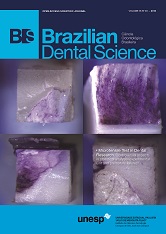Surface roughness evaluation of in vitro refinished dental ceramics followed by bleaching treatment
DOI:
https://doi.org/10.14295/bds.2013.v16i3.886Abstract
Objective: The objective of this study was to evaluate the effect of refinishing process on dental ceramics roughness and the effect of bleaching treatment with 16% carbamide peroxide. Materials and methods: Specimens of 5x3x1mm were produced in two groups (n=14 per group) of dental ceramics following manufacturers' instructions: IPS d.Sign (Ivoclar-Vivadent); and VMK-95 (Vita). A profilometer was used to evaluate the surface roughness (Ra values) of all ceramics acquiring 3 profiles with five 0.25 mm cut-off (?c) at 0.1 mm/s, in four times. The first time was baseline as a negative control, followed by bur roughening (91-126 µm-grit) to simulate an oclusal adjustment in the second time (positive control). After that, the specimens were submitted to refinishing treatments with diamond burs with fine (2135F – 37-44 µm-grit) and extra fine (2135FF – 20-40 µm-grit) diamond burs (third time); and polishing with abrasive cups and paste (fourth time). After refinishing, the two ceramics were divided into a bleached (BL) and non-bleached (NB), with 4 subgroups (n=7 per group). Bleaching was performed daily for 6-hours with 16% carbamide peroxide for 21 days, while NB groups were stored in artificial saliva. The effect of refinishing treatment on ceramics were evaluated by to 2-way ANOVA and Tukey’s test; bleaching effect on refinished ceramics were evaluated by T test. Results: There were no statistical significant differences on surface roughness between ceramics on each refinishing treatments times. The adjustment of dental ceramics with diamond burs drastically increases the surface roughness. The solely treatment with fine and extra fine diamond bur reduced but did not reverse the ceramic surface roughness. The sequential refinishing with abrasive cups and paste reverted the surface roughness to values similar to baseline. Bleaching treatment did not affect the surface roughness of refinished ceramics. Conclusion: Acceptable surface roughness was obtained after refinishing with polishing abrasive cups and paste. The 16% carbamide peroxide treatment was not able to alter the refinished ceramic surface roughness.
Downloads
Downloads
Additional Files
Published
How to Cite
Issue
Section
License
Brazilian Dental Science uses the Creative Commons (CC-BY 4.0) license, thus preserving the integrity of articles in an open access environment. The journal allows the author to retain publishing rights without restrictions.
=================




























